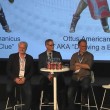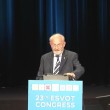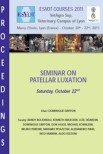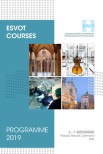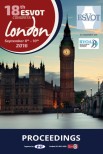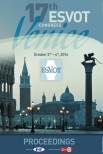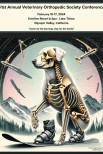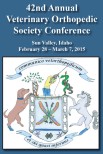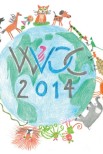Geoff Robins
BVetMed, FACVSc. Director of St Lucia Surgical Services ST. Lucia, QLD, Australia.
G.S-S. As I recall you graduated from the RVC, University of London and then furthered your experience at the RVC and Guelph, before deciding to accompany your new wife to her homeland - Australia. Please give readers a short overview of that time and how you became what might be called ‘have knife and drill and will travel’.
G.M.R…After graduation from the Royal Vet College in London in 1969, I was very fortunate to be appointed as a House Surgeon at the RVC for two years. Here I worked with some wonderful mentors; Professor Cliff Formston as the head of the department, Professor Les Vaughan and Gary Clayton-Jones in orthopaedics and Dr Gordon Baker in soft-tissue surgery. In 1971 I met Professor Jim Archibald and Dr Geoff Sumner-Smith at a conference and they encouraged me to apply for a new position - resident in small animal surgery - at the University of Guelph. I spent two very happy years in Guelph working with Drs. Geoff Sumner-Smith and Dr.Joe Dingwall in small animal surgery, plus a host of other wonderful people in allied fields like radiology, pathology and clinical pathology. I also met and married a lovely Australian lady called Barbara Cox, who was also working at the University doing an internship in radiology. In 1973 we moved to Sydney to take a position in private practice working for Dr John Holt. I rationalised that I had been in an academic track for four years, teaching veterinary students to be practitioners, but I had never had much personal experience in this area. After 1 year in practice I took a position as a lecturer in small animal surgery at the University of Queensland in Brisbane, under the recently appointed professor, Mike Rex. After 16 years here I felt that is was time to move on. I was having difficulty juggling the demands of University to be an administrator, teacher, clinician and research worker. So for 10 years I joined Dr Richard Eaton-Wells in his specialist surgical practice in Brisbane. At this stage I confess to feeling a little burned-out and toyed with the concept of retirement! However not wishing to let-go completely, I approached John Lapish of Veterinary Instrumentation (UK) to see if they needed an agent in Australia. So after a slow beginning the business of supplying implants and instruments to the profession in Australia and New Zealand has grown enormously. Simultaneously colleagues asked me if I would give them a hand with surgical procedures and after a tentative start, this side of my life has also grown into another full time occupation. So I am now on the road five days a week doing between two and three procedures daily, while my physiotherapy trained daughter, Sarah, runs the instrument business with the help of Phil, a trained veterinary nurse. I am available to give technical advice – such as: “I have this femoral fracture; please send me some me a plate and some screws!!”
G.S-S. In your surgical referral practice are you mainly called in for orthopaedic operations, or do you still do some soft-tissue work?
GMR…Circumstances dictate that I have to restrict the scope of the procedures that I perform. Currently I am booked about 3 weeks ahead so clearly this doesn’t leave much room for the acute trauma cases. However I am not totally confined to orthopaedic cases, such as cruciate ruptures and patellar luxations; I have been known to perform laryngeal tie-backs, total ear canal ablations and anal sac resections! Brisbane is blessed with 3 world-class private referral clinics, as well as the University clinic, so there is plenty of choice for clients with patients with more complex problems.
G,S-S In your experience as a veterinary orthopaedic surgeon you must have developed some ideas, instruments or techniques that are your own. Would you care to share some with readers?
GMR ... You could say that I have failed as an orthopaedic surgeon as I have no instruments named after me nor do I have an eponymous surgical procedure. The closest I got to this exulted status was when the students at the Queensland University Veterinary School named the spur left behind after a poorly executed excision arthroplasty “Robins’ Ridge”!! However I can look back at my career and feel that I have been involved, with others, in the early development of plating pelvic fractures, investigating and treating Dobermans with cervical vertebral abnormalities and with elbow dysplasia. I was also involved in describing some of the first cases osteochondritis in joints other than the shoulder (stifle and hock). Perhaps the publication in 1982 with Richard Read on tibial plateaux deformity has had the most long lasting impact. So it is perhaps fitting that I now spend most of my days operating on dogs with cruciate ligament problems by altering their tibial plateaux angle. I have enjoyed a wonderful 10 years of collaboration with Warrick Bruce, a brilliant young veterinary orthopaedic surgeon from NZ. He developed the Triple Tibial Osteotomy technique and in conjunction with Veterinary Instrumentation (UK) some specific instruments to make the surgery easier and more precise. One of the pleasures of being involved with VI is the opportunity to develop ideas and having an input into the manufacture of implants for specific problems in small animal orthopaedics
G.S-S Great things are happening in orthopaedics in general. Do you see any of them being used in animal surgery, and if so which ones?
GMR... Lately there seems to be a great deal of interest in the use of locking screws and plates. I am not sure if this is a fad or something that is here to stay – only time will tell. Clearly in our work we now see fewer fractures and many more cases of joint disease. So the development of specific stem cell therapies to help with cartilage re-growth is very exciting and I foresee this as being something that will become more widely available; as will the use of genetic testing for the diagnosis specific orthopaedic diseases. What I would like to see is more work done on the aetiopathogenesis of cruciate ligament disease and patellar luxation.

